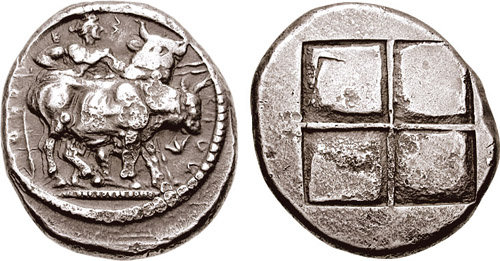
Known only from their coinage, the Orreskioi, like many of the other Thraco-Macedonian groups, inhabited the mountainous region along the Strymon River which divided Macedon, Paionia, and Thrace, though the exact location remains uncertain. Their name may almost certainly derive from the Greek ορεσκωοι, meaning mountainfolk, an epithet associated since Homer with the wild, mountain-bred Centaurs. The lack of any evidence for the Orreskioi in the Greek authors indicates an apparent lack of interest in the region prior to the rise to international prominence of the Macedonian royal house in the fourth century BC. What is clear is that the region's coining authorities adopted a common weight standard and designs based on regional mythological associations: the horseman, or Ares type may refer to the Homeric hero Diomedes, renowned for his fire-breathing horses; the satyr-maenad type alluding to Dionysos; and the herdsman, or Hermes type, as evidenced by this coin and the contemporary oktadrachm of Getas, king of the Edones (see lot 223 above), which refers to the theft by the infant god of the cattle of the Sun (Apollo). Macedon had a close connection with both gods; in fact, the caduceus continued to be employed as a brand on Macedonian horses. The royal house, however, apparently found the allusion of the herdsman design too ambiguous or deemed it inappropriate as the new iconography. It therefore did not continue the type among its own regal types; instead choosing the horseman as its early type.
THRACO-MACEDONIAN TRIBES, The Orreskioi. Circa 479-465 BC. AR Oktadrachm (28.34 gm). ORR-E-Σ-KION (Σ and N reverted), herdsman, holding two spears, guiding two bulls, one with head reverted, right upon dotted groundline; flower to right / Quadripartite incuse square. AMNG III 2 = HPM pl. V, 4 = Traité pl. XLV, 10 = BMC Macedonia pg. 145, 1 (same obverse die); Boston MFA 591 = E.P. Warren,
A Guide to the Catharine Page Perkins Collection of Greek and Roman Coins, (Museum of Fine Arts, Boston, 1902), 93 (this coin); SNG ANS -.